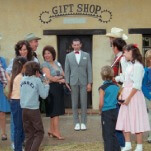Where to start with the enigmatic music known as shoegaze

Pop culture can be as forbidding as it is inviting, particularly in areas that invite geeky obsession: The more devotion a genre, series, or subculture inspires, the easier it is for the uninitiated to feel like they’re on the outside looking in. But geeks aren’t born; they’re made. And sometimes it only takes the right starting point to bring newbies into various intimidatingly vast obsessions. Gateways To Geekery is our regular attempt to help those who want to be enthralled, but aren’t sure where to start. Want advice? Suggest future Gateways To Geekery topics by emailing [email protected].
Geek obsession: Shoegaze
Why it’s daunting: By its nature, shoegaze is a hard thing to penetrate. Suffused with swirling, disorienting, blearily processed guitar, the style coalesced out of a cloud of influences in 1988, when My Bloody Valentine released its game-changing album Isn’t Anything. Imperviously heavy and sweetly melodic, it quickly inspired a glut of soundalikes—although there were other random antecedents, most notably Cocteau Twins and The Jesus And Mary Chain. Drawing from atmospheric post-punk and droning psychedelia, shoegaze received an extra boost of inspiration from the U.S. underground scene, most notably big-guitar groups like Hüsker Dü and Sonic Youth. Shoegaze rose in a parallel arc to the similarly trippy Madchester sound, but where Madchester was outgoing, shoegaze was introverted—hence its name, originally meant as a derogatory term that referred to the scene’s notoriously shy stage presences. After reaching its apotheosis with My Bloody Valentine’s 1991 masterpiece, Loveless, shoegaze petered out quickly, although numerous bands have tried to keep the dense, senses-pummeling sound alive since then, with varying degrees of success.
Possible gateway: Ride, Going Blank Again
Why? Loveless may be shoegaze’s Platonic ideal, but it can also be overwhelming to inner ears that aren’t accustomed to that level of sonic vertigo. Ride’s second album, 1992’s Going Blank Again, hits the sweet spot at the center of pop accessibility, conventional songwriting, and galaxy-sized swathes of noise. In a way, it almost picks up where The Cure’s Disintegration—a large influence on shoegaze—leaves off, steeping pristine jangle in deep pools of echo and melancholy. The disc’s eight-minute opener, “Leave Them All Behind,” is a practically a gateway to shoegaze unto itself; from it’s tremolo-laden intro to its pterodactyl-cry guitar, the song showcases everything otherworldly and breathtaking about shoegaze. At the same time, the album as a whole hints at the broader palette of textures and influences that Ride was soon to incorporate.
Next steps: The gold standard of shoegaze, My Bloody Valentine’s Loveless is overshadowed by its own towering reputation. Set aside the story of its long, legendary creation and numerous innovations, and what’s left is a batch of dreamy, beautiful pop songs that sometimes get lost in all the hyperbole. It’s true that mastermind Kevin Shields spent years painstakingly perfecting the album in the studio, and that the sampling and recording techniques he used changed guitar rock (or certain subsets of it) forever. But Loveless, gorgeous as it is, stands as more of a frozen moment than the beginning of an epoch.




![HBO teases new Euphoria, Larry David, and much more in 2026 sizzle reel [Updated]](https://img.pastemagazine.com/wp-content/avuploads/2025/12/12100344/MixCollage-12-Dec-2025-09-56-AM-9137.jpg)



































